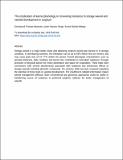| dc.contributor.author | Mwenda, Emmanuel | |
| dc.contributor.author | Ringo, Justin | |
| dc.contributor.author | Mbega, Ernest | |
| dc.date.accessioned | 2023-09-08T08:29:59Z | |
| dc.date.available | 2023-09-08T08:29:59Z | |
| dc.date.issued | 2019-09-01 | |
| dc.identifier.uri | https://doi.org/10.1016/j.jspr.2019.06.010 | |
| dc.identifier.uri | https://dspace.nm-aist.ac.tz/handle/20.500.12479/1924 | |
| dc.description | This research article was published by Elsevier Ltd. in 2019 | en_US |
| dc.description.abstract | Storage weevil is a major biotic insect pest attacking sorghum during late harvest or in storage condition. In developing countries, the infestation can be up to 83% within first six months, and may cause grain loss of 15–77% within the period. Kernel phenotypic characteristics such as pericarp thickness, testa, hardness and kernel size contributes to host plant resistance; through provision of physical barrier for insect penetration and space for oviposition. These traits have connections with several biochemicals associated with antibiosis and antixenosis effects to storage weevils including phenolic compounds. On contrary, little has been reviewed regarding the potential of these traits in varietal development. The insufficient collated information makes weevil management difficult. Both conventional and genomics approaches could be useful in transferring source of resistance to preferred sorghum cultivars for better management of weevils. | en_US |
| dc.language.iso | en | en_US |
| dc.publisher | Elsevier Ltd. | en_US |
| dc.subject | Research Subject Categories::NATURAL SCIENCES | en_US |
| dc.title | The implication of kernel phenology in convening resistance to storage weevil and varietal development in sorghum | en_US |
| dc.type | Article | en_US |

